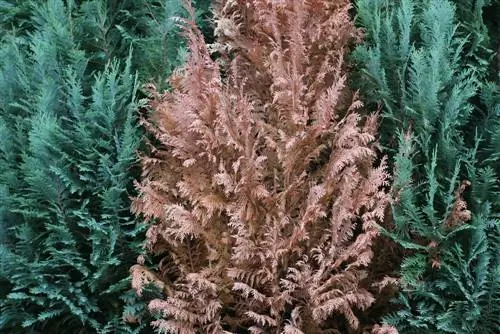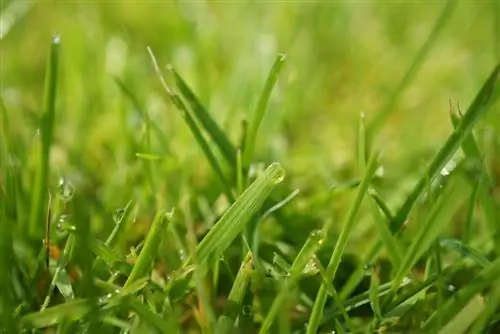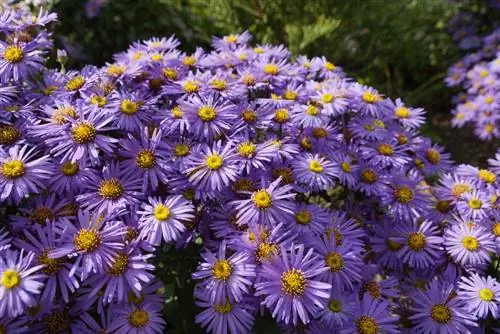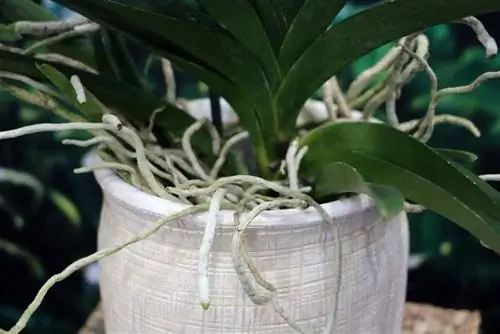- Author admin [email protected].
- Public 2023-12-17 03:39.
- Last modified 2025-06-01 06:48.
So that the garden awakens in full bloom in spring, it needs to be cared for professionally in autumn. Lawns, hedges, ponds and flowering plants need a lot of attention in different ways this time of year. The following checklist shows exactly what a gardener has to do in the autumn months.
Garden in autumn: This work is coming up
Autumn months are high season for gardening because every area needs to be prepared for hibernation. Wrapping delicate plants warm, raking leaves, cutting back branches and wilted flowers, planting tubers and bringing in the harvest - these are the tasks that need to be done. Potted plants that need reliable protection against the cold deserve special attention. It is also important to think about the safe wintering of pond inhabitants.
Lawn in autumn
- Mow once or twice
- Remove leaves thoroughly
- Collect fallen fruit
Plant growth slows down in the fall and then comes to a standstill in the winter. The grass also grows slower, the lawn has to be mowed less frequently and no longer has to be mowed from November onwards. The optimal cutting height is approx. 4 cm. Leaves should be removed from the lawn so that the grass can sprout in spring. The fallen fruit should also be collected because it simply looks unsightly. The lawn can be scarified again in September.
Cutting bushes, trees and hedges
- Cutting back branches
- Cutting down trees
- Cutting hedges
Many shrubs grew vigorously in the summer, but the growth also weakens the plants. In order for the bushes to get through the winter well, they must be cut back. How short to cut back is a matter of taste. Most shrubs can tolerate radical pruning, so hazelnut trees or lilacs, for example, can be cut back as far as possible without any concerns. Trees must also be felled in the fall, if planned. Between March 1st and September 30th Incidentally, no trees may be felled (with a few exceptions). Late autumn is a good time for this work, especially because the metabolism of the plants is now slowed down and they hardly contain any water.
Hedges also need to be cut in autumn and spring. Boxwoods may be cut back heavily. A certain degree of caution is required with conifers, because not all varieties tolerate thorough pruning: While the yew has no problems with this, a cut into the old wood of the thuja or cypress (also false cypress) can lead to the formation of unsightly bald spots.
Tip:
Didn't have time to trim the hedge in autumn? Hedges made from deciduous trees can also be cut in winter.
Harvest
- Harvest pears, apples early
- Thinking about the last tomatoes and pumpkins
- Harvesting late potatoes in October
Autumn is harvest time, all fruits in the garden should be harvested during this time and then stored or processed in a dry and cool place. Even if some tomatoes may still be green, they can still be harvested - they will ripen at room temperatures. The last pears and apples are also to be harvested; some fruits are welcome to remain on the trees. On the one hand, these look decorative, and on the other hand, they serve as a source of food for birds. Potatoes (late varieties) should also be removed from the ground by October at the latest. After the potato plant has wilted, it is the right time to harvest the tubers.
Tip:
Most fruits and vegetables should be harvested before the first frost. Red and white cabbage can tolerate some frost and can be harvested later.
Winter protection for plants
- Use leaves as a protective layer
- Wrap sensitive plants with fleece and fabric
- Bring potted plants into the house or pack them well
In autumn, all plants must be prepared as best as possible for the cold winter. Withered leaves piled up around the roots provide good protection.
Tip:
Wet leaves are not blown away so quickly by the wind, so water the leaf layer a little for more strength.
Sensitive plants and young fruit trees appreciate additional protection. In the case of standard roses, the grafting site in particular should be protected with a layer of fleece. Camellias or azaleas, as well as other plants that are only partially hardy, also need to be wrapped up warm. In addition to the fleece already mentioned, jute fabric, coconut mats and special plastic material from the garden center are also suitable as “packaging material”.
Tip:
Plants must never be wrapped in plastic film (cling film or tarpaulin); all winter protection materials should be permeable to air.
Potted plants that were allowed to enjoy the warmth and rain outdoors on the terrace or in the garden in summer must be brought indoors. The optimal location for these plants is a winter garden, whether heated or not. At room temperatures and relatively little light, most plants do not come to rest and continue to grow, which weakens them.
Tip:
If potted plants (e.g. robust conifers) overwinter outside, they must be wrapped up thoroughly. The soil in the pot (bucket) must under no circumstances freeze!
Autumn as planting time
- Transplanting shrubs and trees
- Planting container roses
- Planting tubers of spring bloomers
Most plants take a break in the fall, so now is the best time to transplant them. Almost all shrubs and trees can be transplanted before the first frost, but ensure there is sufficient moisture. Extended dry periods - not uncommon in autumn - can cause serious damage to a young plant. A plant with soil or pot balls is less sensitive than a bare-rooted plant and therefore tolerates the change of location better. Container roses can also be planted in late autumn, preferably before the first frost. September-October is a good time to plant bulbs of tulips, hyacinths, daffodils and other spring bloomers.
Tip:
Pay close attention to the planting depth, otherwise the young shoots will have difficulty finding their way to the light in spring. Mark the places where the tubers will be planted, because the tubers will remain invisible until March-April.
Pond care in autumn
- Protect against the leaves
- Think about winter quarters for pond inhabitants
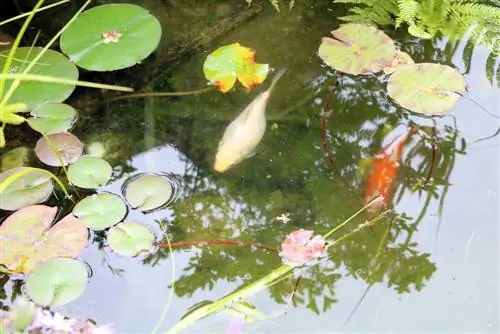
If deciduous trees grow not far from the pond, the small body of water should be protected from falling leaves with a net. The reason - too much rotting leaves on the ground harms aquatic plants and pond inhabitants. If the garden pond is not deep enough and threatens to “freeze” in winter, consider finding winter quarters for koi or goldfish in a fish farm.
Frequently asked questions
Should ornamental grasses be cut back in autumn?
No, garden professionals recommend leaving the dry grasses over winter.
Should you also fertilize in autumn?
Yes, but the dosage should be reduced; fertilization can be stopped from November.
Things to know about gardening in autumn
- Planting conifers: Small conifers (conifers) can stay in the same pot for many years. They are planted in structurally rich soil with a high proportion of coarse bark mulch. During the winter months, water only moderately and avoid waterlogging.
- Planning for spring: Grape hyacinths, crocuses and tulips are now placed in boxes and pots. From November onwards, provide light winter protection with brushwood or a layer of peat.
- Repotting climbers: Every 3 to 4 years, climbing plants grown in pots need new soil. For clematis and wisteria, this is the best time to repot.
- Harvesting seeds: the annual climbing plants run out of steam in autumn. But before you dispose of them, harvest seeds from nasturtiums, runner beans and morning glories for cultivation next year.
- Put away fuchsias: Before putting away fuchsias, cut off all wilted leaves and flowers and cut back shoots that are too long.
- Put away the geraniums: The balcony classics should come into the bright, 5 °C cool winter quarters by the end of October at the latest. First break out all the flowers and shorten the shoots by half.
- Trimming angel trumpets: We recommend using a saw for thick branches. However, do not cut back the flowering area completely, which can be recognized by the asymmetrical leaves.
- Cutting clematis: Varieties that bloomed in summer are cut back to 20 cm. Do not shorten spring bloomers.
- Contain fungal diseases: collect all diseased and dropped leaves and flowers. In doing so, you remove the breeding ground for most types of fungi and prevent the pathogens from overwintering on the balcony.
- Check storm safety: Weigh down weak planters with large pebbles. Tighten the screws on box hangers and hanging baskets.
- Winterizing: Ornamental trees in pots are covered with fir branches or wrapped sparingly. This not only protects them from drying out when the winter sun shines on the bark and leaves.

